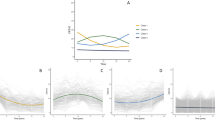Abstract
The trajectory, or slope, of cognitive decline may provide differentiation of older adults with and without incipient neurodegenerative disease. Cognitive aging phenotypes based on memory trajectories could be used as outcome measures for clinical trials or observational studies of risk and protective factors for dementia. This study used growth mixture modeling (GMM) to identify trajectory groups based on age- and education-corrected composite memory scores derived from immediate, delayed and recognition trials of the Selective Reminding Test. Participants included 2593 participants initially without dementia (mean age at entry = 76) in a community-based study of aging and dementia in northern Manhattan. Trajectory groups were compared on consensus diagnoses of dementia and structural MRI measures of hippocampal volume and entorhinal cortical thickness. Heterogeneity in memory trajectories allowed us to identify four groups: Stable-High (43.5 %), Stable-Low (17.1 %), Decliner (26.8 %), and Rapid Decliner (12.5 %). Decliners had more brain atrophy and higher rates of conversion to dementia. This study highlights the heterogeneity in cognitive aging and provides evidence that most elderly maintain memory function as they age. Associations with dementia and imaging measures validate subgroups of older adults identified with GMM based on their memory trajectories. Future research should use these memory trajectory phenotypes to determine whether dementia risk and protective factors differ for individuals following different memory trajectories.




Similar content being viewed by others
References
Crystal H, Dickson D, Fuld P et al (1988) Clinico-pathologic studies in dementia: nondemented subjects with pathologically confirmed Alzheimer’s disease. Neurology 38:1682–1687
Monsell SE, Mock C, Hassenstab J et al (2014) Neuropsychological changes in asymptomatic persons with Alzheimer disease neuropathology. Neurology 83:434–440
Hayden KM, Reed BR, Manly JJ et al (2011) Cognitive decline in the elderly: an analysis of population heterogeneity. Age Ageing 40:684–689
Muniz Terrera G, Brayne C, Matthews F, the CC75C Study Collaboration Group (2010) One size fits all? Why we need more sophisticated analytical methods in the explanation of trajectories of cognition in older age and their potential risk factors. Int Psychogeriatr 22:291–299
Jack CR, Knopman D, Jagust W et al (2013) Update on hypothetical model of Alzheimer’s disease biomarkers. Lancet Neurol 12:207–216
Tang MX, Cross P, Andrews H et al (2001) Incidence of AD in African-Americans, Caribbean Hispanics, and Caucasians in northern Manhattan. Neurology 56:49–56
Collie A, Maruff P (2000) The neuropsychology of preclinical Alzheimer’s disease and mild cognitive impairment. Neurosci Biobeh Rev 24:365–374
Buschke H, Fuld PA (1974) Evaluating storage, retention, and retrieval in disordered memory and learning. Neurology 24:1019–1025
Siedlecki KL, Manly JJ, Brickman AM, Schupf N, Tang M-X, Stern Y (2010) Do neuropsychological tests have the same meaning in Spanish speakers as they do in English speakers? Neuropsychology 24:402–411
American Psychiatric Association (1987) Diagnostic and statistical manual of mental disorders, revised, 3rd edn. American Psychiatric Association, Washington, DC
McKhann G, Drachman D, FolsteinM Katzman R, Price D, Stadlan EM (1984) Clinical diagnosis of Alzheimer’s disease. Report of the NINCDS-ADRDA Work Group under the auspices of the Department of Health and Human Services Task Force on Alzheimer’s disease. Neurology 34:939–944
McKeith IG, Perry EK, Perry PH (1999) Report of the second dementia with Lewy body international workshop: diagnosis and treatment. Neurology 53:902
Roman GC, Tatemichi TK, Erkinjuntti T et al (1993) Diagnostic criteria for research studies: report of the NINDS-AIREN International Workshop. Neurology 43:250
Brickman AM, Schupf N, Manly JJ et al (2008) Brain morphology in older African Americans, Caribbean Hispanics, and whites from northern Manhattan. Arch Neurol 65:1053–1061
Brickman AM, Zahodne LB, Guzman VA et al (2015) Reconsidering harbingers of dementia: progression of parietal lobe white matter hyperintensities predicts Alzheimer’s disease incidence. Neurobiol Aging 36:27–32
Bleecker ML, Bolla-Wilson K, Agnew J, Meyers DA (1988) Age-related differences in verbal memory. J Clin Psychol 44:403–411
Verhaeghen P, Salthouse TA (1997) Meta-analyses of age-cognition relations in adulthood: estimates of linear and nonlinear age effects and structural models. Psychol Bull 122:231–249
Piccinin AM, Muniz G, Clouston S et al (2013) Coordinated analysis of age, sex, and education effects on change in MMSE scores. J Gerontol B Psychol Sci Soc Sci 68:374-390
Morgan AA, Marsiske M, Whitfield KE (2008) Characterizing and explaining differences in cognitive test performance between African American and European American older adults. Exp Aging Res 34:80–100
Acknowledgments
This study was funded with support from the National Institute on Aging (grant numbers AG047963, AG037212, AG034189, AG007232). The funding source had no role in the design and conduct of the study; collection, management, analysis, and interpretation of the data; preparation, review, or approval of the manuscript; or decision to submit the manuscript for publication. On behalf of all authors, the corresponding author states that there is no conflict of interest.
Author information
Authors and Affiliations
Corresponding author
Ethics declarations
Conflicts of interest
All authors declare no conflict of interest.
Etical standard
All participants gave informed consent before entering the study. The study was approved by the Institutional Review Boards at Columbia University.
Rights and permissions
About this article
Cite this article
Zahodne, L.B., Wall, M.M., Schupf, N. et al. Late-life memory trajectories in relation to incident dementia and regional brain atrophy. J Neurol 262, 2484–2490 (2015). https://doi.org/10.1007/s00415-015-7871-8
Received:
Revised:
Accepted:
Published:
Issue Date:
DOI: https://doi.org/10.1007/s00415-015-7871-8




